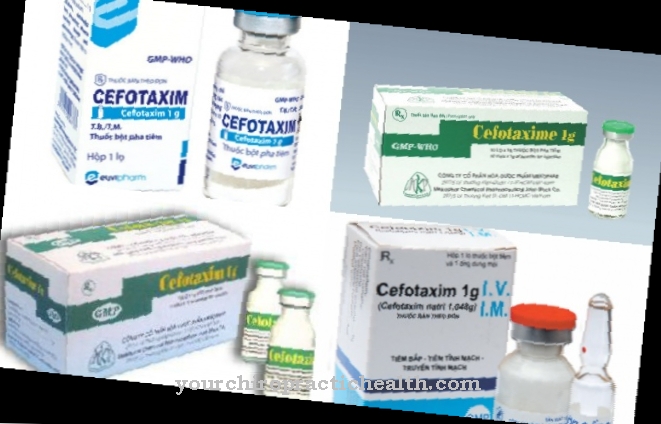Propofol is the most commonly used narcotic in general anesthesia and intensive care medicine. It has a sedating effect, shuts off memory and consciousness and, in combination with analgesics and muscle relaxants, is used to induce and maintain anesthesia. Due to the short duration of action, it is very easy to control, but risks and side effects can occur.
What is Propofol?
Propofol is a medicinal substance and belongs to the group of narcotics. It is a fast acting general anesthetic. The lipophilic active ingredient cannot be completely dissolved in water and is therefore produced in the form of a fat emulsion. Soybean oil is mostly used for this. Instead, new products also use a mixture of triglycerides and long-chain fatty acids to enable use by people with soy intolerance.
The clear, colorless to light yellow liquid is given intravenously. The duration of action is very short at five to ten minutes. Propofol is the most widely used narcotic worldwide and is mainly used in general anesthesia and intensive care medicine. It has a memory and consciousness shutdown effect and is used in the medical field for the induction and maintenance of anesthesia. Due to its good tolerance, it is also used for sedation.
The first synthesis of propofol took place in 1970, clinical tests were carried out a few years later. It has been approved for anesthesia and intensive medical use since 1993.
Pharmacological effect
Propofol is a hypnotic with a calming or numbing effect, but not a pain reliever. The advantage over other anesthetics lies in falling asleep more comfortably and less nausea after waking up.
The way in which propofol induces the sleep-like state during anesthesia is not fully known. It acts on certain receptors in the hippocampus and the cerebral cortex. These areas are responsible for memory, short and long-term memory, and decision-making skills.
In addition, the conduction of stimuli from the spinal cord to the brain is blocked. These effects set in just 30 seconds after the injection into the vein, when the active ingredient has reached the tissue in the brain with the best blood supply. Thereupon a redistribution also takes place in the less perfused brain regions.
Propofol has a very short duration of action. Propofol must be administered at regular intervals to prevent regaining consciousness after five to ten minutes. The active ingredient is mainly excreted via the liver and kidneys and small amounts are exhaled in the air. After about two hours, the body has eliminated half of the active ingredient.
Propofol cannot be safely combined with all medications without interactions. For example, antihypertensive agents are strengthened by propofol, while other substances, such as various pain relievers, prolong its effects.
Medical application & use
Propofol is used in various medical fields. The big advantage is the good controllability due to the short duration of action. In laparoscopic minimally invasive interventions such as a gastrointestinal mirror, it is injected in a lower, sedating dose.
In general anesthesia and intensive care medicine, it is used to induce and maintain anesthesia. Intravenous anesthesia is maintained using a combination of propofol and an analgesic, as well as a muscle relaxant, since propofol does not relieve pain or relax the muscles. In analgesics, opioids are mostly used. The aim is to build up a sufficient concentration of the active ingredient in the blood, which is maintained by a computer-controlled syringe pump.
The dosage is calculated taking into account the age and body weight of the patient and the planned duration of use. In the course of intensive treatment, propofol can only be used in adults, but not in adolescents under 16 years of age, to prevent life-threatening propofol infusion syndrome. Outside of intensive care medicine, it can be used in children from the 2nd month of life due to its good tolerance. However, due to the placental barrier, the administration of propofol is contraindicated during pregnancy, childbirth and breastfeeding.
You can find your medication here
➔ Medicines for painRisks & side effects
Like any drug, Propofol can have risks and side effects. Since it is given intravenously, irritation of the vein wall can cause pain at the injection site. Headache, nausea, and vomiting may occur upon waking, although these symptoms are significantly reduced with Propofol compared to other anesthetics.
Further risks lie in respiratory depression up to respiratory arrest, slow pulse rate and hypotension. This occurs mainly in older patients with previous cardiac damage.
In addition, there may be arousal phenomena such as involuntary movements or muscle twitching, and rarely seizures. A release of histamine is also possible, whereupon some people show intolerance reactions.
If propofol is used for a long time, the propofol infusion syndrome can occur in rare cases, which often leads to death. To prevent this, the propofol administration must not last longer than seven days.
Propofol is often misused due to its relaxing, euphoric and aphrodisiac effects. This usually does not lead to physical, but very much to psychological dependence and can be acutely life-threatening.




























.jpg)